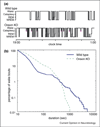Control of arousal by the orexin neurons
- PMID: 23683477
- PMCID: PMC3783629
- DOI: 10.1016/j.conb.2013.04.008
Control of arousal by the orexin neurons
Abstract
The orexin-producing neurons in the lateral hypothalamus play an essential role in promoting arousal and maintaining wakefulness. These neurons receive a broad variety of signals related to environmental, physiological and emotional stimuli; they project to almost every brain region involved in the regulation of wakefulness; and they fire most strongly during active wakefulness, high motor activation, and sustained attention. This review focuses on the specific neuronal pathways through which the orexin neurons promote wakefulness and maintain high level of arousal, and how recent studies using optogenetic and pharmacogenetic methods have demonstrated that the locus coeruleus, the tuberomammillary nucleus, and the basal forebrain are some of the key sites mediating the arousing actions of orexins.
Copyright © 2013 Elsevier Ltd. All rights reserved.
Figures


References
-
- Schiff ND, Plum F. The role of arousal and “gating” systems in the neurology of impaired consciousness. J Clin Neurophysiol. 2000;17:438–452. - PubMed
-
- Pfaff D, Ribeiro A, Matthews J, Kow LM. Concepts and mechanisms of generalized central nervous system arousal. Ann N Y Acad Sci. 2008;1129:11–25. - PubMed
-
- Van Dongen HP, Maislin G, Mullington JM, Dinges DF. The cumulative cost of additional wakefulness: dose–response effects on neurobehavioral functions and sleep physiology from chronic sleep restriction and total sleep deprivation. Sleep. 2003;26:117–126. - PubMed
Publication types
MeSH terms
Substances
Grants and funding
LinkOut - more resources
Full Text Sources
Other Literature Sources

